Those are two different things, "equi-" and "non-equi" joins are independent of the logical join type.
"Equi-join" is when all columns in ON clause are matched on equality, for example ON t1.c1 = t2.c1 AND t1.c2 = t2.c2.
"Non-equi-join" is when one or more columns are using an inequality comparison (e.g. < less than, > more than, <> not equal etc.), for example ON t1.c1 = t2.c1 AND t1.c2 > t2.c2.
Both "equi-join" and "non-equi-join" may be used together with any logical join, e.g. INNER JOIN, OUTER JOIN, LEFT JOIN, RIGHT JOIN, etc.
I found the following diagram from Complex SQL.com site to be the easiest way to understand it:

You can read further details for example in An Illustrated Guide to the SQL Non Equi Join or SQL Joins on Beginner SQL Tutorial.
